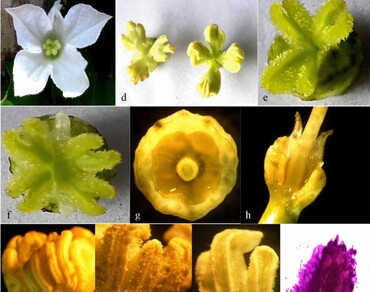Cytomorphological studies on wild and cultivated vines of Coccinia grandis (L.) Voigt
Research Articles | Published: 18 January, 2022
Online ISSN : 2229-4473.
Website:www.vegetosindia.org
Pub Email: contact@vegetosindia.org
First Page: 493
Last Page: 501
Views: 1626
Keywords:
Flower, Anthesis, Dehiscence, Fruit, Meiosis, Mitosis
Abstract
Present study is based on three accessions of wild and cultivated plants of Coccinia grandis. As dioecious taxa, separate male and female plants are present. Male plants are present in wild only whereas the female are both wild and cultivated. Both these plants (wild and cultivated) were studied for morphological features, floral phenological events, reproductive efficiency and cytological details in male track. These were tagged at Jammu, Samba and Kathua districts of Jammu province, UT J&K, India. Morphologically, no difference was observed between three accessions of cultivated and wild female plants. In term of sexual reproductive output, wild female vines have high percentage fruit set than cultivated vines in all three accessions. Among three accessions of both wild and cultivated female vines, Kathua accession has more fruit set on open pollination than Jammu and Samba accessions. The species also shows fruit set on bagged flowers which are deprived of pollen, points toward the incidence of apomixis. Cytologically, this species was found to be stable with normal chromosome number (2n = 24).

(*Only SPR Members can get full access. Click Here to Apply and get access)
References
Deshpande SV, Patil MJ, Parmar KK, And DSC, Khodade RB (2011) A study of antioxidant activity of fruit extract of Coccinia grandis ( L.) Voigt. Int J Drug Res Technol 1:69–72
Garcia RC, Resend FV, Marcosa AA, Toloi DP, Faleiros JAG, Turquino RP, de Souza S (1998) Study of melon pollination by Apis mellifera in the green house. UNIMAR Ciencias 7:123–131
Ghadge AM, Karmakar K, Devani RS, Banerjee J, Mohanasundaram B, Sinha RK, Sinha S, Banerjee AK (2014) Flower development, pollen fertility and sex expression analyses of three sexual phenotypes of Coccinia grandis. BMC Plant Biol 14:325
Guha A, Sinha RK, Sinha S (2005) Cytological, cytochemical and electrophoretic distinction of a dioecious cucurbit Coccinia indica. Cytologia 70:53–57
Imbumi MD (2004) Coccinia grandis (L.) Voigt. In: Grubben GJH, Denton OA (eds) PROTA 2: vegetables/legumes. Wageningen, PROTA
Moideen K, Sherief SH, Sengottuvelu S, Sivakumar T (2011) Hepatoprotective and antioxidant activity of Coccinia grandis root extract against paracetamol induced hepatic oxidative stress in Wistar albino rats. In: ayurveda and pharmacy. Int J of Res. 2:858–863
Niazi J, Singh P, Bansal Y, Goel RK (2009) Anti-inflammatory, analgesic and antipyretic activity of aqueous extracts of fresh leaves of Coccinia indica. Inflammopharmacology 17:219–244
Pangsuban S, Bamroongrugsa N, Kanchanapoom K, Nualsri C (2009) Facultative apomixis in Garcinia atroviridis (Clusiaceae) and effects of different pollination regimes on reproductive success. Trop Lif Sci Res 20:89–108
Parkash KB, Sajjanar SM, Kuberappa G, Prabuswami HP, Eswarappa G (2004) Effect of number of bee visits on fruit sets and some fruit characters in Cucumis sativus. Advances in Pollen Spore Research 22:127–130
Pekamwar SS, Kalyankar TM, Kokate SS (2013) Pharmacological activities of Coccinia grandis: review. J Appl Pharm Sci 3:114–119
Renner SS, Pandey AK (2013) The Cucurbitaceae of India. Phytokeys 20:53–118
Sakharkar P, Chauhan B (2017) Antibacterial, antioxidant and cell proliferative properties of Coccinia grandis fruits. Avecenna J Phytomed 7:295–307
Selvan T, Thirunavukkarasu T, Elumalai K, Balaji R (2014) Pharmacognosy of Coccinia grandis: review. Asian Pac J Trop Biomed 1:299–302
Shaina TJ, Beevy SS (2015) Reproductive biology of Coccinia grandis (L.) Voigt, a dioecious vegetatively propagated cucurbit: evidence for facultative apomixes. Int J Plant Reprod Bio 7:67–77
Sinha S, Guha A, Sinha B, Sinha RK, Banerjee N (2007) Average packing ratio and evolution of sex chromosomes in dioecious Coccinia indica and Trichosanthes dioica. Cytologia 72:369–372
Yadav RN, Agarwala M (2011) Phytochemical analysis of some medicinal plants. J Phyt 3:10–14
Yadav G, Mishra A, Tiwari A (2010) Medical properties of Ivy Gourd (Cephalandra indica)—a review. Int J Pharm Res Dev 2:92–98
Acknowledgements
One of author “Sharma P” is thankful to the UGC- SAP II for financial support.
Author Information